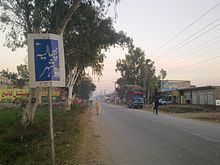Tehsil Phalia Union Councils Total 21 Population 115,618 (2011) Dialling code 546 | Region Punjab Administrator Bilal Feroz Joya AC Postal code 50430 Area code 0546 | |
 | ||
District | ||
History of mandi bahauddin malakwal phalia flv
Phalia (Urdu تحصیل پھالیہ ) is a Tehsil of Mandi Bahauddin District, Punjab, Pakistan. The population of Phalia was calculated to be 25,914 in 2007 (21,025 in 1998).
Contents
- History of mandi bahauddin malakwal phalia flv
- Map of Phalia Pakistan
- History
- Geography and climate
- Schools
- Colleges
- AIOU Study Center
- Health facilities
- Phalia City
- Administration
- Notable people
- References
Map of Phalia, Pakistan
History
Alexander the Great and his army crossed the Jhelum in July 326 BC at the Battle of the Hydaspes River where he defeated the Indian king Porus. According to Arrian (Anabasis, 29), he built a city on the spot whence he started to cross the river Hydaspes, which he named Bukephala or Bucephala to honour his famous and loyal horse Bukephalus or Bucephalus. It is thought that ancient Bukephala was near the site of modern Jhelum City but that is wrong. Phalia was named after Bucephalus on the name of the Alexander's dead horse and presently a tehsil of Mandi Bahauddin District. The Alexander while forwarding from Taxila opted alternate way despite of using traditional route i.e. today's GT road and built two cities on opposite banks of the river Hydaspes en route between Bhera and Mong.
In 997 CE, Sultan Mahmud Ghaznavi, took over the Ghaznavid dynasty empire established by his father, Sultan Sebuktegin, In 1005 he conquered the Shahis in Kabul in 1005, and followed it by the conquests of Punjab region. The Delhi Sultanate and later Mughal Empire ruled the region. The Punjab region became predominantly Muslim due to missionary Sufi saints whose dargahs dot the landscape of Punjab region. Jalalpur Sharif is located on west of the river Jhelum whereas Phalia on eastern bank in Mandi Bahauddin District close to river Jhelum earlier known as Hydaspes. A semi hill or mound i.e. the historical sign of the ancient city and a shrine still available in mid of the Mohalla Ameer. In 2010, maximum of the area reshaped into commercial land and precious heritage could not be preserved.
After the decline of the Mughal Empire, the Sikh invaded and occupied Bahawalnagar District. The Muslims faced severe restrictions during the Sikh rule. During the period of British rule, Bahawalnagar increased in population and importance.
The predominantly Muslim population supported Muslim League and Pakistan Movement. After the independence of Pakistan in 1947, the minority Hindus and Sikhs migrated to India while the Muslims refugees from India settled down in the Bahawalnagar District.
Phalia is approximately the same age as Lahore . The four subdivisions (Mohallas) are named for the forefathers of Tarar tribe:
Geography and climate
Phalia is situated at 32.43 N latitude and 73.58 E longitude. It is located between the main cities of Mandi Bahauddin and Gujrat, about 23 kilometres from Mandi Bahauddin and 50 kilometres (31 mi) from Gujrat and 45 kilometres (28 mi) from Malakwal and near about 80 kilometres (50 mi) from Salam interchange on M-2 motorway, at an altitude of 672 feet (205 m) above sea level.
Phalia has a moderate climate, which is hot in summer and cold in winter. During peak summer, the day temperature rises up to 40 °C (104 °F). The winter months are mild and the minimum temperature may fall below −2 °C (28 °F) . The average annual rainfall in the district is 50 millimetres (2.0 in).
Schools
There are many other govt and private schools in Phalia.
Colleges
AIOU Study Center
Health facilities
Health Medical facilities are on average available in the city. The main government hospital established in the city is THH (Tehsil Headquarters Hospital). There are several other private hospitals, Health center and Clinics at different locations within the city.
Phalia City
Phalia is not a big city, with about 20,000 houses occupied by about 150,000 people. Most of the population of the village are Muslim with some Christians.
Punjabi is the native language of the province and is the most widely spoken language in Phalia. Urdu has started to become more prominent in many areas now due to its official status as the national language.
The number of registered voters in the Constituency PP-117 (Mandi Bahuddin-II) Phalia is 134,119 . among them almost half of them are of female voters.
Administration
After the abolition of Nazim system the Administrator of Phalia is Assistant Commissioner Bilal Feroz Joya 2016.
